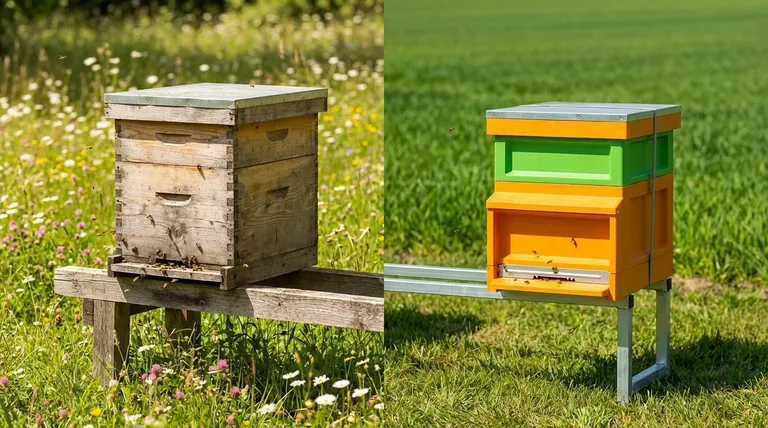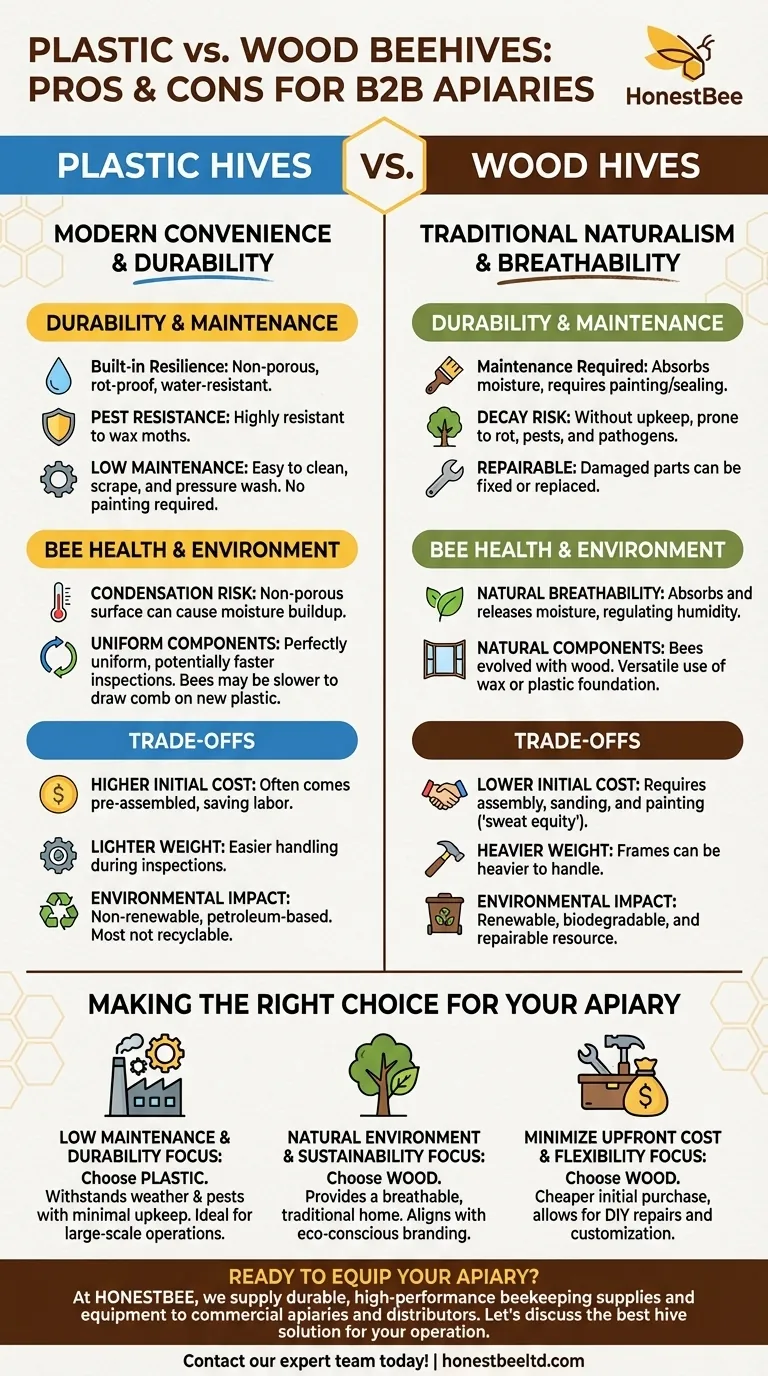At its core, the choice between plastic and wood beehives is a decision between modern convenience and traditional naturalism. Plastic hives offer superior durability, pest resistance, and low maintenance, making them easy to manage. In contrast, wood hives provide a natural, breathable environment for bees and are made from a renewable resource, though they require regular upkeep.
The decision is not about finding a universally "better" material. It is about aligning your beekeeping philosophy and operational capacity with the right set of trade-offs—choosing between the manufactured resilience of plastic and the organic, breathable nature of wood.

Durability and Maintenance
The most significant difference between wood and plastic lies in how they withstand time and the elements. This directly impacts the amount of work required from the beekeeper.
Plastic's Built-in Resilience
Plastic hive components are non-porous and impervious to moisture. This means they will not rot, warp, or degrade from exposure to rain and humidity.
This material is also highly resistant to pests like wax moths, which cannot burrow into the hard plastic. Cleaning is simple, as components can be scraped and pressure washed for easy sterilization.
Wood's Maintenance Requirements
Wood is a natural material that absorbs moisture. To prevent rot and extend its life, wooden hive bodies must be protected with paint or a weather-resistant sealant before use and repainted every few years.
Without proper maintenance, wood can decay, providing crevices for pests and pathogens to hide. However, damaged wooden parts can often be repaired, whereas cracked plastic usually requires replacement.
Bee Health and the Hive Environment
The hive material creates the micro-environment where the colony lives. This choice has direct consequences for temperature and humidity regulation.
The Critical Issue of Condensation
Plastic's non-porous surface is its biggest environmental drawback. It cannot absorb moisture, leading to condensation buildup inside the hive, especially during cold weather. This excess moisture can stress the colony and increase the risk of disease.
Wood, being a natural fiber, is "breathable." It absorbs a small amount of moisture from the air inside the hive and releases it, helping to passively regulate humidity and create a drier, healthier winter environment for the bees.
Natural vs. Uniform Components
Many beekeepers prefer wood because it is a natural material that bees have evolved with for millions of years. Wooden frames also offer versatility, allowing the use of either natural wax or plastic foundation.
Plastic frames and foundations are perfectly uniform and durable, which can speed up inspections. Some beekeepers observe that bees are sometimes more reluctant to draw out comb on new plastic foundation compared to wax-coated wood frames.
Understanding the Trade-offs
Choosing a hive material involves balancing upfront cost, long-term sustainability, and ease of use. Each material presents a distinct set of advantages and compromises.
Cost and Labor
Plastic hives can sometimes have a higher initial purchase price but often come pre-assembled and ready to use, saving labor.
Wooden hive kits are typically less expensive upfront but require assembly, sanding, and painting, which represents a "sweat equity" investment.
Weight and Handling
While hive body weights can be comparable, plastic frames are often lighter and more manageable than their wooden counterparts, making inspections less strenuous.
Environmental Impact and End-of-Life
Wood is a renewable, biodegradable, and repairable resource. At the end of its life, a wooden hive can be composted or burned.
Plastic hives are made from petroleum, a non-renewable resource. Most beekeeping plastics are not recyclable, and if they become brittle or cracked from UV exposure, they end up in a landfill.
Making the Right Choice for Your Apiary
Your decision should be guided by your specific goals as a beekeeper. There is no single correct answer, only the best fit for your situation.
- If your primary focus is low maintenance and durability: Plastic is the superior choice, as it withstands weather and pests with minimal upkeep.
- If your primary focus is a natural hive environment and sustainability: Wood provides a more breathable, traditional home for bees and is a renewable resource.
- If your primary focus is minimizing upfront costs and maximizing flexibility: Wood hives are often cheaper to purchase and allow for DIY repairs and customization.
Ultimately, the best hive is one that helps you maintain a healthy, thriving colony in a way that aligns with your personal beekeeping goals.
Summary Table:
| Feature | Plastic Hives | Wood Hives |
|---|---|---|
| Durability | High; rot-proof, pest-resistant | Moderate; requires painting/sealing |
| Maintenance | Low; easy to clean | High; needs regular upkeep |
| Bee Environment | Risk of condensation | Natural breathability |
| Initial Cost | Potentially higher | Typically lower |
| Sustainability | Non-renewable, not recyclable | Renewable, biodegradable |
| Weight | Lighter frames | Heavier frames |
Ready to equip your apiary with the right hives?
At HONESTBEE, we supply durable, high-performance beekeeping supplies and equipment to commercial apiaries and distributors. Whether you're scaling up with low-maintenance plastic hives or prefer the traditional benefits of wood, our wholesale-focused operations ensure you get the quality and reliability your business depends on.
Let's discuss the best hive solution for your operation. Contact our expert team today!
Visual Guide

Related Products
- Wholesales Dadant Size Wooden Bee Hives for Beekeeping
- Beehive Entrance Discs Plastic Bee Entrance Disc for Bee Hives
- Yellow Plastic Bucket Pail Perch for Beekeeping
- HONESTBEE Advanced Ergonomic Stainless Steel Hive Tool for Beekeeping
- Professional Galvanized Hive Strap with Secure Locking Buckle for Beekeeping
People Also Ask
- What should beginners consider when purchasing beekeeping equipment? A Guide to Essential Starter Gear
- What are the characteristics of oil-based paint for beehives? Durability vs. Modern Practicality
- What are the advantages of wooden bee hives? Superior Bee Health & Beekeeper Flexibility
- What are the essential pieces of equipment for most beekeepers? Get Started with the Right Gear
- How often should the area under beehives be inspected and cleaned during the warm season? A Proactive Maintenance Guide



















